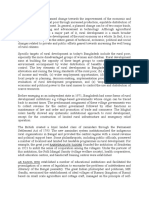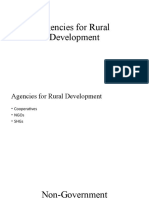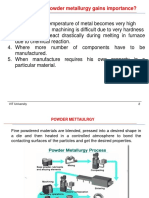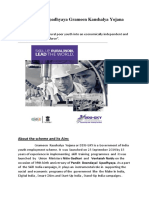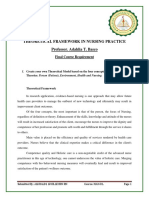Rural Development Before and After Independence: Chapter - 2
Rural Development Before and After Independence: Chapter - 2
Uploaded by
Jawa freakCopyright:
Available Formats
Rural Development Before and After Independence: Chapter - 2
Rural Development Before and After Independence: Chapter - 2
Uploaded by
Jawa freakOriginal Title
Copyright
Available Formats
Share this document
Did you find this document useful?
Is this content inappropriate?
Copyright:
Available Formats
Rural Development Before and After Independence: Chapter - 2
Rural Development Before and After Independence: Chapter - 2
Uploaded by
Jawa freakCopyright:
Available Formats
S.K. Acharya, G.C. Mishra and Karma P.
Kaleon
CHAPTER - 2
Rural Development Before and
After Independence
2. Introduction
The district of Saharsa played an important part in the freedom
movement. The Home rule movement of Annie Besent in -
1917 and Styagarah Movement of Mahatma Gandhi in 1921
received widespread support in the district. In Saharsa, the
freedom movement was led, among others, by Sarvashri
Mahtal Lal Yadava, Shivanandan Mandal, Nand Kishore
Chaudhary, Rajendra Mishra, Ram Bahadur Sinha,
Yadunanadan Jha and Rajendra Lal Das. Supaul and
Madhepura Jails were full of Political prisioners. Thana Bihpur
(in Bhagalpur district) was the scene of great activity where Dr.
Rajendra Prasad was bitterely beaten by the police and the
people of Saharsa were much agitated over this picketing tool
place all over the district with full Vigour. The Period between
RURAL DEVELOPMENT IN INDIA: A STUDY OF SAHARSA DISTRICT OF BIHAR
ISBN: 978-93-85822-16-2 16
Dr. Saroj Kumar Singh
1930 and 1942 was marked by various Kishan agitations all
over the district for Bakast lands.
Rural development is an obligation of the Government to raise
the standard of living of the rural people. Since independence,
the Government has initiated developmental planning measures
and implemented through Five Year Plans. So far, though eight
Five Year Plans have been implemented, the problem of rural
poverty and unemployment has remained largely unsolved.
Even basic infrastructure facilities also are launching in most
of the Villages. The Integrated Rural Development Programme
(IRDP) is an organized effort to evolve the possibility of
developing infrastructural facilities along with inter-sectoral
avenue in an integrated framework at micro-level.’ It is not
merely a programme of rural development but a combined
effort under which all-rural development programs, which were
in vogue, were integrated. It represents a significant
achievement in the field of organization. The evolution of
lRDP has a historical background. But before discussing it, it is
essential to know what is rural development and what are the
rural development efforts before and after independence.
2.1. The Concept Of Rural Development
In India, the concept of rural development was born in the
context of agriculture and it remained for a long time
continuous with agricultural development.
RURAL DEVELOPMENT IN INDIA: A STUDY OF SAHARSA DISTRICT OF BIHAR
ISBN: 978-93-85822-16-2 17
Rural Development Before and After Independence
The objectives of rural development, according to the World
Bank, are not restricted to any single Department but spread
over several, and the resultant mlx serves to raise agricultural
output, create new employment, improve health and education,
expand communication, provide housing etc. Thus, the World
Bank defined rural development in terms of an improvement of
the economic and social life of the rural poor. Rural
development encompasses all sectors of rural life. In its widest
sense, it implies development of every aspect of rural life.
The basic objectives of mal development is to organize,
develop and utilize the available resources of land, water, and
manpower in such a manner that the entire population
depended on these resources have an equitable Government of
India, Planning Commission, Interim Report on Integrated
Agricultural Development opportunity to meet, as a minimum
in its basic needs. Rural development involves:
1. Improvement in levels of weaker sections of the rural
population, as indicated by income, productivity, employment,
literary rate, health and nutrition, infant mortality rate,
expectation of life, exposure to mass media, housing, political
participation, status of women, supply of safe drinking water
and similar other minimum needs.
2. Decreasing the inequality in distribution of rural wealth and
incomes,
RURAL DEVELOPMENT IN INDIA: A STUDY OF SAHARSA DISTRICT OF BIHAR
ISBN: 978-93-85822-16-2 18
Dr. Saroj Kumar Singh
3. Decreasing the inequality in rural-urban imbalances in
incomes and economic opportunities,
4. Capacity of the rural sector to sustain and accelerate the pace
of the above mentioned improvement over time.
G.R. Krishnaswamy's views on rural development involves
several categories of integration such as, integration of
different sectors of the rural economy with forward and
backward linkages, economic development with social
development, total area approach and target group approach,
credit with technical services, human resource development
with manpower needs and integration of income generating
schemes with the minimum needs programme of education,
rural health, water supply and nutrition.
2.2. Definitions of Rural Development
The Rural Development sector Policy Paper of the World Bank
(1975) observes that "rural development is a strategy designed
to improve the economic and social life of a specific group of
people - the rural poor. It involves the extension of the benefits
of development to the poorest among those who seek a
livelihood in the rural areas. The group includes small scale
farmers, tenants and the landless.""
Again a World Bank publication defines rural development as
"improving the living standards of the low-income population
residing in rural areas and making the process of their
RURAL DEVELOPMENT IN INDIA: A STUDY OF SAHARSA DISTRICT OF BIHAR
ISBN: 978-93-85822-16-2 19
Rural Development Before and After Independence
development self-sustaining"? It consists of development of
Villages in to healthy, self-sufficient, and prosperous units of
living and provides the basic requirements for a healthy and
comfortable living.
In a seminar on Approaches to Rural Development in Asia,
discussions were centered around a definition of rural
development as a process which lead to a continuous rise in the
capacity of the rural people to control their environment,
accompanied by a wider distribution of benefits resulting from
such control"' This definition is composed of three important
elements:
I. Rural development must be viewed as a process of raising
the capacity of the rural people to control their environment.
Environment does not mean only agricultural or economic
development. It includes all aspects of rural life - social,
economic, cultural and political,
2. Rural Development as a process should continuously raise
the capacity of the rural people to influence their total
environment, enabling them to become initiators and
controllers of change in their environment rather than being
merely the passive objects of external manipulation and
Control, and
3. Rural development must result in wider distribution of
benefits accruing from technical developments and the
RURAL DEVELOPMENT IN INDIA: A STUDY OF SAHARSA DISTRICT OF BIHAR
ISBN: 978-93-85822-16-2 20
Dr. Saroj Kumar Singh
participation of weaker sections of the rural population in the
process of development.
Michael Torado mews that rural development encompasses:
1. Improvement in levels of living including employment,
education, health and nutrition, housing and a variety of social
services,
2, Decreasing inequality in the distribution of rural incomes
and in rural-urban balances in Incomes and economic
opportunities, and
3. The capacity of the rural sector to sustain and accelerate the
pace of these.
The famous sociologist, James H Crops has defined rural
development as a process through collective efforts, aimed at
improving the well-being and self-realization of people living
outside the urbanized area. He further contends that the
alternate target of rural development is people and not
infrastructure and according to him, one of the objectives of
rural development should be to widen people's range of choice.
Mishra and Sunderam defined mal development as not merely
development of rural areas but also the development of quality
of life of the rural masses in to self-reliant and self-sustaining
modem little communities. Rural development IS therefore
development of rural areas in such a way that each component
of rural life changes in a desired direction. Another scholar,
RURAL DEVELOPMENT IN INDIA: A STUDY OF SAHARSA DISTRICT OF BIHAR
ISBN: 978-93-85822-16-2 21
Rural Development Before and After Independence
Lassey emphasizes that the focus of rural development should
be on.
I. Preservation of ecological integrity with a view to provide a
continuous Supply of life-supporting resources,
2. Extent and appropriate land use,
3. Healthy living conditions,
4. An aesthetically pleasing environment,
5. Effective socio-economic and Environmental institutions,
6. Improved human welfare in terms of minimum economic
and social Level,
7 Physical structures adopted and landscape of pleasing design,
and
8. Comprehensiveness, that is, the full range of physical,
biological and factors in ruins.
The Ashridge Conference on Social Development defined rural
development as a movement designed to promote better living
for all in the whole community with the active participation
and initiative of the community.' According to UN Report,
"rural development has come into international usage to
connote the process by which the efforts of people themselves
are united to those of Governmental authorities to improve the
economic, social and cultural conditions in the life of the
nation and to relate them to contribute fully to national.”
RURAL DEVELOPMENT IN INDIA: A STUDY OF SAHARSA DISTRICT OF BIHAR
ISBN: 978-93-85822-16-2 22
Dr. Saroj Kumar Singh
In the words of Robert Chambers, "rural development is a strategy to enable
a specific group of people, poor rural women, and men to gain for
themselves and their children more of what they want and need. It involves
helping the poorest among those who seek a livelihood in the rural areas to
demand and control more of the benefits of rural development. The group
includes small-scale farmers, tenants and landless.’- Thus rural development
is a multi-dimensional process which includes the development of socio-
economic conditions of the people living in the rural areas and ensures their
participation in the process of development for complete utilization of
physical and human resources for better living conditions. It extends the
benefits of development to the weaker and poorer sections of rural society.
It also enhances both the capacity and capability of administrative and
socio-economic development agencies and agricultural marketing units
working in the rural areas.
2.3. Rural Development during the British Rule--------
Since time immemorial, India has been predominantly a rural
country. Thus, rural development has always been in the
priority concern of national development. In those days, our
villages were self-sufficient and self-sustained and the
respective rulers made any effort for the betterment in their
conditions. But during the British rule, they were not
concerned with the socio-economic development of India and
thus our rural economy was severely damaged resulting in the
miserable conditions of the rural. It was the famine of 1899,
RURAL DEVELOPMENT IN INDIA: A STUDY OF SAHARSA DISTRICT OF BIHAR
ISBN: 978-93-85822-16-2 23
Rural Development Before and After Independence
which forced the British Government to think about the people
of India who were dying of hunger. The recurrent famines
forced the State Administrators to seize the food grains and
arrange for the distribution among the famine-affected people.
All was done without any apparent legal sanction, motivated as
the action purely was by determination to control profiteering
and alleviate rural suffering." Later, with the recommendations
of Famine Commissions of 1866 and 1880 and with the
initiative of Lord Curzon, Provincial Department of
Agriculture with Agricultural College and Provincial Research
Institute were established in 1906 the Indian Agricultural
Service was constituted. A number of British officers
according to their interest and inclination tried out a few
experiments in rural reconstruction. The spread of such
Programs were thin and only small financial outlays could be
made for them. They were not pursued with any noticeable
sense of urgency. The primary concern of the administrations
as maintenance of law and order and collection of revenue, not
development. Thus, colonial interests were the primary
objectives and rural development was secondary.
2.4. Rural Development During The Pre-Independence
Period
In the pre-independence period, a number of rural development
programs were started by the Nationalists and Social reformers.
RURAL DEVELOPMENT IN INDIA: A STUDY OF SAHARSA DISTRICT OF BIHAR
ISBN: 978-93-85822-16-2 24
Dr. Saroj Kumar Singh
Some of these programs gradually disappeared or some were
merged with Government sponsored schemes later. 'This is
because of various reasons like lack of encouragement of the
Government, lack of financial support, inadequate,
inexperienced and untrained staff. The other reasons are lop-
sided approach to different aspects of development, absence of
needed supplies and services, inadequate co-ordination and co-
operation from other departments and agencies. There are
many efforts i.e. Gandhian Approach in Rural Development in
Champaran, Bihar (1917), Gandhian Experiment in Rural
Reconstruction (1920), Sriniketan Project (1921) of Poet
Rabinder Nath Tagore, Marthamdom Project (1921)– Spencer
Hatch of YMCA, Gurgaon Project (1927) – F.LK. Bryne,
Rural Reconstruction Movement (1932) – V.T.
Krishanmachari, Sevagram (1936) – Mahatma Gandhi, Grow
More Food Campaigns 1942 – F.L.Bryne, Indian village
upliftment Scheme in 1945, were started for rural development.
But, the most important rural development efforts during the
pre-independence era were:
1. Rural Reconstruction programme by Mahatma Gandhi
2. The Sriniketan Experiment
3 The Martandam Experiment
4. The Gurgaon Experiment
5. Rural Reconstruction Programs in Baroda, and
RURAL DEVELOPMENT IN INDIA: A STUDY OF SAHARSA DISTRICT OF BIHAR
ISBN: 978-93-85822-16-2 25
Rural Development Before and After Independence
6. The Firka Development scheme.
2.4.1 Rural Reconstruction Programme by Mahatma
Gandhi
Mahatma Gandhi started the programs for rural reconstruction
at Sevagram in Wardha In 193 8. His 18-point Constructive
Programme included the use of khadi, promotion of village
industries, basic education, adult education, rural sanitation,
removal of untouchability, upliftment of the backward classes,
welfare of women, education in public health and hygiene,
prohibition, propagation of mother tongue and economic
equality.
The Gandhian Constructive Programme is essentially a
programme of human activity in various fields that is beneficial
for the economic growth of rural India. Gandhiji wished to
evolve a philosophy of life, which would achieve the welfare
of all (Sarvodaya).
Gandhiji was greatly disturbed by the decline of rural
industries. He believed that the extinction of Village industry
would complete the ruin of 7,00,000 villages He gave special
attention to revive rural crafts especially spinning and weaving,
traditional oil press, grain processing and leather works.
According to Gandhi, the return to traditional village industry
could ensure full employment and well-being to the
overwhelming population of the country. This philosophy
RURAL DEVELOPMENT IN INDIA: A STUDY OF SAHARSA DISTRICT OF BIHAR
ISBN: 978-93-85822-16-2 26
Dr. Saroj Kumar Singh
inspired and informed the activities of Gandhiji to the
constructive workers who dedicated their lives to village
development programs. Gandhian rural reconstruction
activities were based on the principles of truth and non-
violence. His ideas of rural reconstruction were accepted
officially and resulted in the adoption of Khadi and Village
Industries Programme, the principle of Village Self-
sufficiency, and the faith in the Panchayati Raj and Sahakari
Movement by the Government are some of the examples of the
impact of Gandhian tradition.
2.4.2 Sriniketan Experiment
In 1920, Rabindra Nath Tagore laid the foundation of the
Sriniketan Institute for Rural Reconstruction and formulated a
programme for the all-round improvement in the Village of his
Zamindari with the objective of studying rural problems and of
helping the Villagers to develop agriculture, improving the
livestock, formation of co-operatives. Tagore believed in self-
help and mutual help and wanted the village workers to be
involved in the life of rural people and work for their welfare.
He started this programme in the cluster of 8 Villages but were
not very successful and can only be described as rural welfare
works. The absence of market facilities, professional guidance,
lack of co-ordination between the implementing authority and
improper incentives for workers made the task more difficult
RURAL DEVELOPMENT IN INDIA: A STUDY OF SAHARSA DISTRICT OF BIHAR
ISBN: 978-93-85822-16-2 27
Rural Development Before and After Independence
and desired results could not be achieved. l'he Sriniketan
experiment meant for bringing back life in its completeness
into the Villages, making rural folks self-reliant and en-grading
self-respectful, acquainted with the cultural traditions of their
own country and competent to make an efficient use of modem
resources for the improvement of their physical, intellectual
and economic conditions. Though this experiment was not
success, it attained certain physical and notable results.
2.4.3 The Martandam Experiment
Dr. Spencer Hatch of the Young Men's Christian Association
(YMCA) set up a Project in 1921 at Martandam, 25 miles south
of Thiruvananthapuram. The purpose of this experiment was to
bring about a complete upward development towards a more
complete and meaningful life for rural people, spiritually,
mentally, physically, socially and economically. The main
stress in programme was on the principle that people should
not depend on Government for support because when
concessions and help in any field are not given, the people
develop in them a feeling of self-help and self- reliance.
The objectives of this programme was the YMCA should work
in the Villages to eliminate poverty. For the Rural
Demonstration Centre at
Martandam had a demonstration farm, prized animals,
equipment for the honey industry and other cottage vocations
RURAL DEVELOPMENT IN INDIA: A STUDY OF SAHARSA DISTRICT OF BIHAR
ISBN: 978-93-85822-16-2 28
Dr. Saroj Kumar Singh
in its campus. Some industries like 27 weaving, poultry and
bee keeping were started on a co-operative basis. Dr. Hatch
could demonstrate the lucrative possibilities of these
enterprises -
The major achievements of the programme were the change in
the attitudes of the rural people, formation of a desire to
improve the spirit of cooperation and self-respect. This
experiment was followed by other States and its workers
helped the States of Baroda, Mysore, Cochin and Hyderabad to
set up Centers of Training for Rural Reconstruction.
2.4.4 The Gurgaon Experiment
In 1927, the Gurgaon experiment was started by F.L. Bryne,
who was the Deputy Commissioner of Gurgaon District in
Punjab. The programme aimed at improving agriculture,
education, health and sanitation facilities, co-operation, and
social development with greater vigor. Through these
comprehensive efforts, he intended to remove poverty through
a mass movement. He stressed on the dignity of labour, self-
help and conducted propaganda through films, songs, skits and
plays with a view to increase farm yields and improving health
standards Under this programme, for the first time, a 'Village
guide' was posted In each Village who was to work as a link to
pass on new innovations to the main reason for the failure of
this programme was that the reforms were imposed on the
RURAL DEVELOPMENT IN INDIA: A STUDY OF SAHARSA DISTRICT OF BIHAR
ISBN: 978-93-85822-16-2 29
Rural Development Before and After Independence
people, rather than initiated by themselves. This widened the
gap between the 'haves and have-nots'.
2.4.5 Rural Re-Construction Programme In Baroda
The Maharaja of Baroda was a progressive and enlightened
man and he started the Baroda experiment in 1932. This
programme aimed at developing "will to live better" and a
capacity for self-help and self-reliance. The programme
included the following items:
1. Improvement of communication,
2. Digging of drinking water wells,
3. Anti-malarial measures,
4. Pasture development,
5. Distribution of improved seeds,
6. Training in Cottage crafts,
7. Establishment of Panchayats and Co-operatives covering
every Village,
8. Development of village schools as Centre for teach
agriculture and for improving the will to live better. The
programme had full legislative and financial support.
2.4.6 The Firka Development Scheme
The Firka Development scheme of Madras was a Government
sponsored Scheme in 1946 this programme aimed at organizing
the villagers for a Happier, more prosperous and fuller life in
RURAL DEVELOPMENT IN INDIA: A STUDY OF SAHARSA DISTRICT OF BIHAR
ISBN: 978-93-85822-16-2 30
Dr. Saroj Kumar Singh
which the individual villagers had the opportunity to develop
both as an individual and as a unit of a well-integrated society.
The short term objectives of the scheme was to develop basic
amenities and an institutional framework for carrying out
communication, water supply, sanitation, formation of local
self-governments (i.e. panchayats) and cooperatives: 'The long
term objectives were to attain self-sufficiency in food,
Clothing, shelter, development of agriculture, animal
husbandry, khadi and village industries."
The administrative machinery consisted of Director of Rural
Welfare at the State level, the Collector at District level, the
Rural Welfare Officer at Firka level and 5 to 10 Gramasevaks
under him. Besides these, staffs for Agriculture and Public
Works were also provided for every Firka. Later in 1953-54,
when the Community Development Programme and National
Extension Service Programme were adopted by Madras State,
the Firka Development Scheme was merged with it.
Pre-independent efforts of rural development programs were
limited and confined to specific areas. All pre-independent
efforts were isolated in nature and lacked a permanent
organizational structure (Govt.). As a result, after showing
some initial results, these projects withered away gradually
without any tangible and permanent impact. Thus, various old
programs suffered on account of the following reasons – lack
RURAL DEVELOPMENT IN INDIA: A STUDY OF SAHARSA DISTRICT OF BIHAR
ISBN: 978-93-85822-16-2 31
Rural Development Before and After Independence
of government backing, lack of financial resources, lack of
research support, lack of specialized facilities and lack of
several other related factors. The failures of all the pre-
independent rural development efforts have been summed up in
a comprehensive way as under:
Gaikwad (1986) concluded that:
Earlier experiments were at least poor examples of rural
reconstruction, considering their tall philosophical ideas,
narrow and shallow base of thinking on material aspects of life,
and poor and transient impact on the economy of rural people
and these kept the society rural. In these experiments, there was
not much that would build a technologically progressive
economy. One would like to consider persons like Andrews,
Empires, Miss Green, Dorothy Straight, Dr. Hatch, Brayne,
Myer etc. as representatives of technologically and industrially
advanced Western societies. Yet, they introduced very little of
industry and technology of the west in their experiments.
2.5 Rural Development Since Independence
Immediately after the attainment of independence and before
the commencement of planned economic development through
Five Year Plans, three important programs of rural
reconstruction were introduced in India. They were
1 The Etawah Pillot Project
2 The Nilokheri Experiment
RURAL DEVELOPMENT IN INDIA: A STUDY OF SAHARSA DISTRICT OF BIHAR
ISBN: 978-93-85822-16-2 32
Dr. Saroj Kumar Singh
3 The Bhoodan Movement
2.5.1 The Etawah Pilot Project
In 1948, Albert Mayor started the Etawah Pilot Project for the
development of the rural areas of Etawah District in Uttar
Pradesh. The main objective of the project was "to see what
degree of productive and social improvement as well as
initiative, self-confidence and co-operation can be developed.
The problem was to ascertain how quickly these results may be
attained and remain permanently a part of the people's mental,
spiritual, technical equipment and outlook after the special
pressure is lifted."
The other important features were: production intensity,
people's cooperation, development of appropriate attitudes,
careful selection of Personnel, self-reliance, local resources and
supply and development of Village leadership.
The effort was made to introduce the Concept of Decentralized
Economy leading to Agro-Industrial Economy which in turn
led to the development of agriculture, horticulture, poultry,
piggery, fishery, and other forms of animal husbandry.
For intensive operation of the programme, 97 Villages of
Mahadeva Block in Etawah District were selected. Various
activities llke agricultural Demonstrations, soil conservation,
improvement in animal husbandry, village sanitation and the
co-operation of various departments and non-official agencies
RURAL DEVELOPMENT IN INDIA: A STUDY OF SAHARSA DISTRICT OF BIHAR
ISBN: 978-93-85822-16-2 33
Rural Development Before and After Independence
were carried out. In order to secure people's participation, a
programme of social education was also started. The Project
was successful in achieving its aim and within 3 years, it was
extended to 300 Villages of the Etawah District in UP."
2.5.2 The Nilokheri Experiment
S. K. Dey, the former Minister for Community Development
and Cooperation was the founder of the Nilokheri Experiment
in 1948, when nearly 7000 displaced persons were rehabilitated
in Nilokheri town after independence. The scheme was also
known as "Mazdoor Manzil" because of its principle 'he who
will not work, neither shall he eat'. Under this programme, the
main activities were a Vocational Training Centre run on co-
operative lines and the Colony had its own dairy, poultry,
piggery, printing press, engineering workshops, tannery, and
bone-meal factory. People were given vocational training of
their choice to run these Co-operative Enterprises. Rights for
education and medical care for the sick were also guaranteed.”
The Nilokheri project, in spite of its limitations, left an imprint
on the Community Development Programme in the country. It
gave the idea of agro-industrial Township as the nerve-Centre
of rural development. The programme found place in the First
Five Year Plan and in the layout of the Financial Plan of the
first 52 Community Projects. Nilokheri was seen as a symbol
of progress, but the Colony developed its own hierarchical
RURAL DEVELOPMENT IN INDIA: A STUDY OF SAHARSA DISTRICT OF BIHAR
ISBN: 978-93-85822-16-2 34
Dr. Saroj Kumar Singh
structure and the industries started facing troubles due to lack
of competitive advantages. Nilokhen is still an important
Centre for the training of Panchayati Raj and Rural
Development Functionaries.
2.5.3 The Bhoodan Movement.
Acharya Vinoba Bhave, one of the earlier social reformers of
India is the profounder of Bhoodan movement. In the words of
Vinoba Bhave, Bhoodan Yojana is an all-comprehensive
movement directed to the reform in all walks of life. Today
every one thinks of himself alone and feels for self only. But
Bhoodan makes the people think and do just the opposite of
what they do now. It makes the people first think of their
neighbors, and if he has no land, it must be their duty to
provide him with it. In Bhoodan, distribution of land is not the
only question. It aims at the moral regeneration of the whole
nation. Through it we hope to solve the economic difficulties,
encourage Village Industries and remove the difference
between the educated and the uneducated by making them both
to join in common work."
The inspiration of Bhoodan came to Vinobaji in 1951 when he
was touring the Telangana District of Hyderabad. The basic
objective of Bhoodan campaign was to prevent the emergence
of bloody revolution by solving the land problems in a peaceful
way. The real intention was to create the right atmosphere so
RURAL DEVELOPMENT IN INDIA: A STUDY OF SAHARSA DISTRICT OF BIHAR
ISBN: 978-93-85822-16-2 35
Rural Development Before and After Independence
that progressive land reforms could follow. At one stage, it was
thought that Vinoba had succeeded in converting the minds of
large numbers of big landholders. Acres upon acres and later
Villages &er Villages were shown as being given away to the
landless or the tenants. However, later, it was found that, in
most such cases, the Bhoodan proved to be a sham; in one
manner or another, the large landholders retained the land.
Except above projects, there are many other projects as :
Sarvodaya Program (1948), Fifteen Pilot Extension Projects –
Ford Foundation, Community Development Program (1952) –
Chester Bowel, National Extension Service (NES) 1953,
Panchayati Raj (1959), Intensive Agricultural District Program
(IADP-1960), Intensive Agriculture Area Program (IAAP-
1964), High Yielding Variety Program (HYVP-1966), Training
and Visit (T&V-1974), Small Farmers’ Development Agency,
1970. Marginal Farmers’ Development Agency (1970),
Drought Prone Area Program (1970), Integrated Tribal
Development Program, Integrated Rural Development Program
(1978-79), Training of Rural Youth for Self Employment
(TRYSEM-1975), Integrated Child Development Services
Scheme (1975) were adopted for Rural Development under
Post Independence.
The different rural development attempts during the pre-
planning period, no doubt, did something really good in spite
RURAL DEVELOPMENT IN INDIA: A STUDY OF SAHARSA DISTRICT OF BIHAR
ISBN: 978-93-85822-16-2 36
Dr. Saroj Kumar Singh
of many hurdles. But some of the schemes gradually
disappeared idiom the scene and some were merged later with
Government sponsored schemes. These earlier attempts could
not last long or attain the desired goals for various reasons such
as lack of encouragement from the Government, lack of
necessary financial support, inadequate and untrained staff,
lop-sided approach to different aspects of development and
absence of necessary infrastructure facilities. As noted in the
First Five Year Plan, the experience of early rural
reconstruction schemes reveals that different schemes were
forced on the villagers and as such there was no enthusiasm
among them and there was lack of initiative for the people,
which is very essential for the success of the schemes.
The following problems were encountered in implementing the
Sriniketan Project of 1921 such as lack of Pilot Survey or
Research, lack of University research on technical, social and
economic aspects was a great handicap, pre-planning survey
was not completed, sound professional guidance was not
available from any corner, there was absence of intimate
contact between project workers, government officials and
between officials and the villagers, there was dearth of men
and means to take up the work at large scale, government
officials had little understanding of village problems and had
no experience in sitting down with village people.
RURAL DEVELOPMENT IN INDIA: A STUDY OF SAHARSA DISTRICT OF BIHAR
ISBN: 978-93-85822-16-2 37
Rural Development Before and After Independence
2.6 Post-Independence Rural Development Efforts
After independence, the government of India launched
Community Development Program (CDP) on 2nd October,
1952 and National Extension Service (NES) in 1953 for the
development and upliftment of rural people in general and of
weaker sections in particular. Since independence, rural
development programs have been an integral part of India’s
Five Year Plans. The CDP aimed at the development of the
rural areas with the participation of local population through
the framework of over 5000 C.D. blocks.
2.7. Politics Behind The Initiation Of Cdp In India
Chester Bowel the then U.S. Ambassador in India convinced
Nehru about the urgency of CDP for Indian Villages and
offered to spend 54 million U.S. dollars as economic assistance
to assist some such village campaigns and other programs.
Chester Bowel’s theory:
Chester Bowel observed that communism gained strength in
china because Yen’s (Dr. James Y.C. Yen a graduate of Yale
University) approach was not supported by the general Issimo
in China. Bowel thought that a similar situation would develop
in India if development programs were not undertaken urgently
on the line suggested by Yen. To him, the CDP was a defense
mechanism against his perceived threat of communism to
India. It could be said that Bowl’s influence at a crucial and
RURAL DEVELOPMENT IN INDIA: A STUDY OF SAHARSA DISTRICT OF BIHAR
ISBN: 978-93-85822-16-2 38
Dr. Saroj Kumar Singh
psychologically important moments pushed India to opt for the
Etawah model of CDP in India. The four basic elements of
community development program (CDP) were: Focus on
individual cultivator, restructuring of district administration,
provision of facilities through cooperatives and block and
provision of Welfare at Block and at village levels.
The focus of this design, as in case of all early efforts was on
individual cultivator. There was no emphasis on collective,
communal action for community welfare and on building
community assets for common economic development. In later
years, a number of other programs for rural development were
also adopted.
2.8 Critical Evaluation Of Rural Development Policies &
Programs
A critical appraisal of various welfare programs and projects
have revealed various types of limitations and constraints in the
implementation process. Jain, L.S. (1985) after conducting a
comprehensive study of various programs in various blocks
across the country have found out various constraints in
relation to IRDP (1980-81 to 1983) which need improvement
such as proper identification of beneficiaries need to be there,
removal of deficiency in administrative infrastructure,
involvement of peoples’ representatives, initiation of activities
RURAL DEVELOPMENT IN INDIA: A STUDY OF SAHARSA DISTRICT OF BIHAR
ISBN: 978-93-85822-16-2 39
Rural Development Before and After Independence
in support of the IRDP beneficiaries and required detailed
evaluation.
2.9 Impact and Review
A number of authors, researchers and reviewers have come to
the conclusion that various projects and programs designed for
rural development programs have not succeeded to the desired
extent. The review and analysis of various studies revealed that
the lack of interest in problems connected with rural
community followed by lack of community feelings and
welfare, lack of coordination among village schools, village
panchayats and village cooperatives, caste, region and religion
based factionalism, lack of village plans, lack of coordination
from the center to the block level, multiplicity of
responsibilities of development functionaries cornering of poor
people’s money, paying of low wages to the rural poor and
frequent transfers of specialists and other officers adversely
affected the rural development programs.
Muley (1987) pointed out that rural development has remained
one of the constant and increasingly conscious goals of our five
year plans from their inception, but unfortunately this goal has
eluded us all the time. Devashayam (1988) rightly observed
that:
“As we became a free country, we vowed to banish poverty
from the face of this nation. We heaped many plans including
RURAL DEVELOPMENT IN INDIA: A STUDY OF SAHARSA DISTRICT OF BIHAR
ISBN: 978-93-85822-16-2 40
Dr. Saroj Kumar Singh
20 points programs. Now after 63 years and many development
programs, vast population still lives below the poverty line – a
number equal to the combined population of Europe and USA.
Today, rural areas are being sought to be developed and
poverty removed by dishing out doles through loan meals
organized in feudal style. Development programs in reality
have only helped a microscopic minority to reap all benefits in
the name of concessions and reservations for the majority of
the condemned it is an endless life of misery and squalor.” The
noted Indian Jurist Palkivala (1986:5) observed that : “The
dangers of the mass loaning programs meant for needy people
including rural youth should be clear even to the purblind, in a
country where the family comes first, the caste second the
party third, and the nation is hardly relevant at all”. Similarly,
the Public Accounts Committee of the Indian Parliament in its
90th report (1980-81) has drawn attention to the fact that in
implementing the National Rural Employment Program meant
for rural people and rural youth, there were serious
irregularities on the part of almost all state governments –
corruption, misappropriation, false debits in accounts and
diversion of food grains – and it listed shortcomings of the
program in appendix-III to the report.
International Institute of Transparency has identified India as
one of the leading corrupt countries in the world. Former
RURAL DEVELOPMENT IN INDIA: A STUDY OF SAHARSA DISTRICT OF BIHAR
ISBN: 978-93-85822-16-2 41
Rural Development Before and After Independence
Director of Central Bureau of Investigation, Mr. K. Madhavan
has estimated that annually, an amount of rupees 10,000 crores
is siphoned off through corrupt means out of the welfare
programs meant for the poor people (Warghare, Suresh
Chand). The crores of rupees have been spent on celebrating
the completion of half a century of Indian self-rule. For
example, the government will provide the mostly hungry and
want driven people of Delhi with a laser show costing the
taxpayer Rs. 10 crores. People have experienced 63 distressing
years of sterile politics, stagnant economy and a diminishing
cultural identity. That India is rated low among even the
developing countries in terms of skills and manpower quality.
The India’s trade is reported to have decreased by over a third
of even the one per cent of world trade it enjoyed sixty years
ago. Indecision, vacillation, timidity, corruption, and red-
tapism have characterized and continue to characterize India’s
governance (Puri, 1997).
The money-squandering syndrome can be gauzed from the fact
that since 1951, 246 big surface irrigation projects have been
initiated. Only 65 out of these have been completed. Almost no
benefit has come to the people from these projects. Investments
in major irrigation projects rose from around Rupees 7,500
crores in the sixth plan to over Rupees 11,000 crores in the
seventh plan and are expected to touch Rupees. 25,000 crores
RURAL DEVELOPMENT IN INDIA: A STUDY OF SAHARSA DISTRICT OF BIHAR
ISBN: 978-93-85822-16-2 42
Dr. Saroj Kumar Singh
in the eighth plan and may touch Rupees 50,000 crores in the
9th plan (Vohra, 1996:13).
2.10. Conclusion
The district of Saharsa played an important part in the freedom
movement. The Home rule movement of Annie Besent in -
1917 and Styagarah Movement of Mahatma Gandhi in 1921
received widespread support in the district. In Saharsa, the
freedom movement was led, among others, by Sarvashri
Mahtal Lal Yadava, Shivanandan Mandal, Nand Kishore
Chaudhary, Rajendra Mishra, Ram Bahadur Sinha,
Yadunanadan Jha and Rajendra Lal Das. Supaul and
Madhepura Jails were full of Political prisioners. Thana Bihpur
(in Bhagalpur district) was the scene of great activity where Dr.
Rajendra Prasad was bitterely beaten by the police and the
people of Saharsa were much agitated over this. Picketing tool
place all over the district with full Vigour. The Period between
1930 and 1942 was marked by various Kishan agitations all
over the district for Bakast lands.
The August revolution of 1942 formed a land mark in the
history of the freedom movement in Saharsa district too. On
the 29th of August, there was police firing at Saharsa and a
number of persons were killed. After his escape from the
Hazaribag Jail in 1942 Sri Jay Prakash Narayan visited Saharsa
district on his way to Nepal. Sri Siyaram Singh of Bhagalpur
RURAL DEVELOPMENT IN INDIA: A STUDY OF SAHARSA DISTRICT OF BIHAR
ISBN: 978-93-85822-16-2 43
Rural Development Before and After Independence
formed Siyaramdal, which had its branches in different parts of
the district of Saharsa in December 1942. Sri Siyaram Singh
met Sri Jaya Prakash Narayan in Nepal where a conference on
the works of Bihar was held under the Presidentship of Shri
Shivanandan Mandal.The district played a prominent role in
the subsequent events which continued till the country’s
independence.
●●●
RURAL DEVELOPMENT IN INDIA: A STUDY OF SAHARSA DISTRICT OF BIHAR
ISBN: 978-93-85822-16-2 44
You might also like
- Rural Development - Theories and ApproachesDocument43 pagesRural Development - Theories and Approachesdigvijay90986% (28)
- The Non Formal EducationDocument4 pagesThe Non Formal EducationPearl Joy Mijares100% (4)
- Lamp Fellowship-Policy Analysis EssayDocument2 pagesLamp Fellowship-Policy Analysis EssayshivamNo ratings yet
- 09 Chapter2 PDFDocument24 pages09 Chapter2 PDFBen MathewsNo ratings yet
- 14 - Chapter 3Document19 pages14 - Chapter 3neerajsaroj34567836No ratings yet
- HistoricalBackgroundofRuralDevelopment Paper2Document15 pagesHistoricalBackgroundofRuralDevelopment Paper2Abdul KhadarNo ratings yet
- Rural - Is An Area, Where The People Are Engaged in Primary Industry in The Sense That TheyDocument2 pagesRural - Is An Area, Where The People Are Engaged in Primary Industry in The Sense That TheyTesfaye BerihunNo ratings yet
- Basic Elements of Rural DevelopmentDocument29 pagesBasic Elements of Rural DevelopmentGulnaz GaimaNo ratings yet
- Rural Development - GujaratDocument30 pagesRural Development - GujaratfpkhanzNo ratings yet
- Rural DevelopmentDocument286 pagesRural Developmentsahanagowda82% (11)
- Fundamental of Rural Development by Dr. Sheetal RandhirDocument50 pagesFundamental of Rural Development by Dr. Sheetal Randhiradarshyadav483No ratings yet
- SHWATADocument54 pagesSHWATAAnonymous V9E1ZJtwoENo ratings yet
- INSPIRA JOURNAL OF COMMERCEECONOMICS COMPUTER SCIENCEJCECS Vol 03 N0 03 July Sept 2017 Pages 71 To 74Document4 pagesINSPIRA JOURNAL OF COMMERCEECONOMICS COMPUTER SCIENCEJCECS Vol 03 N0 03 July Sept 2017 Pages 71 To 74Vikram RajputNo ratings yet
- Course: Fundamentals of Agricultural Extension Education: Satwik Bisarya AKSU, Satna (M.P.)Document13 pagesCourse: Fundamentals of Agricultural Extension Education: Satwik Bisarya AKSU, Satna (M.P.)satwik bisaryaNo ratings yet
- Rural DevelopmentDocument3 pagesRural DevelopmentSakshi RaiNo ratings yet
- 1 PPT Unit 1 Rural DevelopmentDocument29 pages1 PPT Unit 1 Rural Developmentsumit sharmaNo ratings yet
- Chapter - 15 Rural DevlopmentDocument21 pagesChapter - 15 Rural DevlopmentJuiÇý ßitëNo ratings yet
- The Concept of Rural Development Meaning & Definition: September 2022Document10 pagesThe Concept of Rural Development Meaning & Definition: September 2022pujakumari2001gNo ratings yet
- Need of Rural Development in India For Nation BuildingDocument8 pagesNeed of Rural Development in India For Nation BuildingAkhila ChandranNo ratings yet
- Significance of Rural Development: Dr. Radhika KapurDocument16 pagesSignificance of Rural Development: Dr. Radhika KapurRay chijiokeNo ratings yet
- Unit 1 RURAL DEVELOPMENT-2-6Document5 pagesUnit 1 RURAL DEVELOPMENT-2-6thedragonwarrior26No ratings yet
- IRDP To NRLM: A Brief Review of Rural Development Initiatives in IndiaDocument4 pagesIRDP To NRLM: A Brief Review of Rural Development Initiatives in IndiainventionjournalsNo ratings yet
- National Law Institute University, BhopalDocument33 pagesNational Law Institute University, BhopalHrishikeshNo ratings yet
- Chapter 123Document16 pagesChapter 123appucr7goatNo ratings yet
- Rural, Rurality and Rural DevelopmentDocument12 pagesRural, Rurality and Rural DevelopmentShweta ShahNo ratings yet
- Inzamam Social Secondary Data ProcessDocument34 pagesInzamam Social Secondary Data Processkaifs2215No ratings yet
- Rural DevelopmentDocument9 pagesRural DevelopmentyounusgulNo ratings yet
- Rural Development Concept and DimensionsDocument25 pagesRural Development Concept and DimensionsDianaCreangăNo ratings yet
- Rural DevevopmentDocument52 pagesRural Devevopmentazom53774255No ratings yet
- Bangladesh StudiesDocument27 pagesBangladesh StudiesMd Fahim Muntasir HeavenNo ratings yet
- 1 - UNIT-1 - Rural Planning & Development - BY MANISH KUMAR SHARMADocument18 pages1 - UNIT-1 - Rural Planning & Development - BY MANISH KUMAR SHARMAmanish kumar sharma100% (2)
- Rural Development PDFDocument19 pagesRural Development PDFP HarishNo ratings yet
- Village, Villagers and Rural Development: Roghayeh GilaniniaDocument6 pagesVillage, Villagers and Rural Development: Roghayeh GilaniniaMuhammad FuadNo ratings yet
- Rural Development Programmes in IndiaDocument4 pagesRural Development Programmes in IndiaVicky VermaNo ratings yet
- Rural Development Planned Change Towards The Improvement of The Economic andDocument4 pagesRural Development Planned Change Towards The Improvement of The Economic andAbrar HamimNo ratings yet
- Assingment Ban EcoDocument28 pagesAssingment Ban EcoKamrul MozahidNo ratings yet
- Assingment Ban EcoDocument24 pagesAssingment Ban EcoKamrul MozahidNo ratings yet
- Rural Development Policy and Planning LeDocument20 pagesRural Development Policy and Planning Leumesh bishtNo ratings yet
- Significance of Rural Development: Acta Scientific Agriculture (Issn: 2581-365X)Document7 pagesSignificance of Rural Development: Acta Scientific Agriculture (Issn: 2581-365X)Amandeep MalikNo ratings yet
- Shyam Lal College (M) : Project-Rural DevelopmentDocument23 pagesShyam Lal College (M) : Project-Rural DevelopmentShivam KumarNo ratings yet
- Programmes Launched by The Government of India For The Rural Development in Pre Economic Reform Era A Cash StudyDocument6 pagesProgrammes Launched by The Government of India For The Rural Development in Pre Economic Reform Era A Cash StudyEditor IJTSRDNo ratings yet
- Concept of Rural Development in IndiaDocument255 pagesConcept of Rural Development in IndiaAnindita GhoshNo ratings yet
- Task 1: Compare Development Models in SAARC Countries.: 1.indiaDocument9 pagesTask 1: Compare Development Models in SAARC Countries.: 1.indiaPravesh DhakalNo ratings yet
- Task 1: Compare Development Models in SAARC Countries.: 1.indiaDocument9 pagesTask 1: Compare Development Models in SAARC Countries.: 1.indiaPravesh DhakalNo ratings yet
- Introduction To Rural Development By:Sakshi Patil Roll No 8129 SybbaDocument7 pagesIntroduction To Rural Development By:Sakshi Patil Roll No 8129 SybbaPjNo ratings yet
- Rural DevelopmentDocument7 pagesRural Developmentqmc599nsm4No ratings yet
- Rural Outreach FileDocument22 pagesRural Outreach FilemokshguptacodNo ratings yet
- Rural Development - Administration & PlanningDocument101 pagesRural Development - Administration & PlanningAkankshaguptaNo ratings yet
- ENRICH: Pathway To Sustainable Development, Human Dignity and ChoiceDocument43 pagesENRICH: Pathway To Sustainable Development, Human Dignity and ChoiceIrfan HyderNo ratings yet
- Dimension of Rural Development in NepalDocument6 pagesDimension of Rural Development in NepalJay KhadkaNo ratings yet
- Project of Rural Development NEW BBADocument14 pagesProject of Rural Development NEW BBAVikram RajputNo ratings yet
- RURAL DEVELOPMENTDocument6 pagesRURAL DEVELOPMENTARAFAT KHALIQNo ratings yet
- Ew201811 01 002571Document4 pagesEw201811 01 002571anupam gopalNo ratings yet
- TG - MTS Sectional - Test - 02 Complete Society - Model - Answers - emDocument26 pagesTG - MTS Sectional - Test - 02 Complete Society - Model - Answers - emashish14fxNo ratings yet
- Monitoring and Evaluating The Contribution of The Rural Development in India and Master Plan For Development of MULHER VillageDocument8 pagesMonitoring and Evaluating The Contribution of The Rural Development in India and Master Plan For Development of MULHER VillageEditor IJTSRDNo ratings yet
- Discuss The Limitations and Improvements of The National Rural Development Policy-2001 PDFDocument10 pagesDiscuss The Limitations and Improvements of The National Rural Development Policy-2001 PDFBushra Khatun Jannat100% (1)
- Rural DevelopmentDocument12 pagesRural DevelopmenttriratnacomNo ratings yet
- Rural Development in Transition: Global TrendsDocument5 pagesRural Development in Transition: Global TrendsPremier Publishers100% (1)
- Globalisation Pushing India's Rural EconomyDocument5 pagesGlobalisation Pushing India's Rural EconomyJiten BendleNo ratings yet
- RAHUL Rural Outreach July-Dec-2024Document27 pagesRAHUL Rural Outreach July-Dec-2024iamrahulraj57No ratings yet
- Numerical Solution of Partial Differential Equations: - (B) Crank-Nicolson Implicit MethodDocument36 pagesNumerical Solution of Partial Differential Equations: - (B) Crank-Nicolson Implicit MethodJawa freakNo ratings yet
- Agencies For Rural DevelopmentDocument18 pagesAgencies For Rural DevelopmentJawa freakNo ratings yet
- Where Powder Metallurgy Gains Importance?: VIT University 2Document12 pagesWhere Powder Metallurgy Gains Importance?: VIT University 2Jawa freakNo ratings yet
- Module-2 System of Linear Equations and Eigen Value Problems Important Numerical Methods in Module-IDocument24 pagesModule-2 System of Linear Equations and Eigen Value Problems Important Numerical Methods in Module-IJawa freakNo ratings yet
- Parvez 4 PDFDocument24 pagesParvez 4 PDFJawa freakNo ratings yet
- FALLSEM2018-19 - CSE1001 - LO - SJTG20 - VL2018191001859 - Reference Material I - Session 15Document33 pagesFALLSEM2018-19 - CSE1001 - LO - SJTG20 - VL2018191001859 - Reference Material I - Session 15Jawa freakNo ratings yet
- FALLSEM2018-19 - CSE1001 - LO - SJTG20 - VL2018191001859 - Reference Material I - Session 17-ADocument67 pagesFALLSEM2018-19 - CSE1001 - LO - SJTG20 - VL2018191001859 - Reference Material I - Session 17-AJawa freakNo ratings yet
- Module-3 Finite Differences and Interpolation: Example: For 0Document10 pagesModule-3 Finite Differences and Interpolation: Example: For 0Jawa freakNo ratings yet
- FALLSEM2020-21 MEE3501 ETH VL2020210100431 Reference Material I 14-Jul-2020 SyllabusDocument3 pagesFALLSEM2020-21 MEE3501 ETH VL2020210100431 Reference Material I 14-Jul-2020 SyllabusJawa freakNo ratings yet
- School of Mechanical Engineering: 1. Quiz - I Before CAT-I 10 10Document1 pageSchool of Mechanical Engineering: 1. Quiz - I Before CAT-I 10 10Jawa freakNo ratings yet
- FALLSEM2020-21 MEE3501 ETH VL2020210100431 Reference Material I 16-Jul-2020 Introduction To Freehand Sketches Layouts SymbolsDocument38 pagesFALLSEM2020-21 MEE3501 ETH VL2020210100431 Reference Material I 16-Jul-2020 Introduction To Freehand Sketches Layouts SymbolsJawa freakNo ratings yet
- Mee3501 - Product Development & Management: Associate Professor, SMECDocument9 pagesMee3501 - Product Development & Management: Associate Professor, SMECJawa freakNo ratings yet
- FALLSEM2020-21 MGT1022 ETH VL2020210100319 Reference Material I 03-Sep-2020 06a. Business PlanDocument13 pagesFALLSEM2020-21 MGT1022 ETH VL2020210100319 Reference Material I 03-Sep-2020 06a. Business PlanJawa freakNo ratings yet
- FALLSEM2020-21 MEE3501 ETH VL2020210100431 Reference Material II 16-Jul-2020 DimensioningDocument65 pagesFALLSEM2020-21 MEE3501 ETH VL2020210100431 Reference Material II 16-Jul-2020 DimensioningJawa freakNo ratings yet
- Challengesmart Cities India PDFDocument34 pagesChallengesmart Cities India PDFJawa freakNo ratings yet
- Deen Dayal Upadhyaya Grameen Kaushalya Yojana Completed PDFDocument5 pagesDeen Dayal Upadhyaya Grameen Kaushalya Yojana Completed PDFJawa freakNo ratings yet
- Construction Safety and Health ManualDocument86 pagesConstruction Safety and Health ManualReggie Rosal100% (1)
- HEAD TO TOE - Health Assessment in Nursing 5th Edition (Weber & Kelley)Document20 pagesHEAD TO TOE - Health Assessment in Nursing 5th Edition (Weber & Kelley)folkloriantaro100% (1)
- 5 - Aratiles-WHOLE PAPER PDFDocument22 pages5 - Aratiles-WHOLE PAPER PDFCindy MarquezNo ratings yet
- 130 Grease EnglishDocument7 pages130 Grease EnglishbuddhansamratNo ratings yet
- Artículo 13Document11 pagesArtículo 13Rosa MuñozNo ratings yet
- Chapter-6 Current Trends of Social DevelopmentDocument66 pagesChapter-6 Current Trends of Social Developmentseidtaju17No ratings yet
- Theoretical Framework in Nursing PracticeDocument4 pagesTheoretical Framework in Nursing Practicemaha_alkhaldiNo ratings yet
- Wasteshed RatesDocument1 pageWasteshed RatesSinclair Broadcast Group - EugeneNo ratings yet
- Exercise 4 Key - Problem 4 p54 C7 p57Document3 pagesExercise 4 Key - Problem 4 p54 C7 p57Güllü DallıNo ratings yet
- Measuring The Safety and Health of Radisson Washing Plant Garment WorkersDocument23 pagesMeasuring The Safety and Health of Radisson Washing Plant Garment WorkersSamiul NafizNo ratings yet
- Lesson 2 EnergyDocument11 pagesLesson 2 EnergyMichael John SongcuanNo ratings yet
- Regular (T, TH, Sat) : Meal 1Document2 pagesRegular (T, TH, Sat) : Meal 1Kristal CruzNo ratings yet
- Dangcagan Disaster Risk Reduction and Management Plan 2017-2019Document104 pagesDangcagan Disaster Risk Reduction and Management Plan 2017-2019Enp Titus Velez100% (1)
- Personal Development: Personal Relationships Quarter 2 - Week 1 - Module 1Document6 pagesPersonal Development: Personal Relationships Quarter 2 - Week 1 - Module 1morphine dreamNo ratings yet
- Patterson On Client Centered Career CounselingDocument10 pagesPatterson On Client Centered Career CounselingGom BearNo ratings yet
- Illustrated Medical Dictionary: Melloni'sDocument4 pagesIllustrated Medical Dictionary: Melloni'sAryan SinghNo ratings yet
- SDS Penguard Midcoat Comp ADocument13 pagesSDS Penguard Midcoat Comp AK3L AJGNo ratings yet
- 7 Acupressure Points For Your Feet To Remove Stress, Headaches and More - NDTV FoodDocument9 pages7 Acupressure Points For Your Feet To Remove Stress, Headaches and More - NDTV FoodAdarsh PatilNo ratings yet
- PerDev Q1W6 The Power of MindDocument36 pagesPerDev Q1W6 The Power of Mindjzwf8m82gjNo ratings yet
- Force of Nature - The Life of Linus PaulingDocument732 pagesForce of Nature - The Life of Linus PaulingPhillipos 19No ratings yet
- Physical Exercises For Preventing Injuries Among Adult Male Football Players: A Systematic ReviewDocument8 pagesPhysical Exercises For Preventing Injuries Among Adult Male Football Players: A Systematic ReviewSara PinheiroNo ratings yet
- Ruby-Benefits of Old Mines BurmaDocument2 pagesRuby-Benefits of Old Mines BurmaM SkumarVNo ratings yet
- Jonas SalkDocument1 pageJonas SalkSuryajeeva SuresNo ratings yet
- Englisch DasWirken 2003 ADocument55 pagesEnglisch DasWirken 2003 Abagus918No ratings yet
- Management of Natural Resources Introduction - Tutorvista PDFDocument2 pagesManagement of Natural Resources Introduction - Tutorvista PDFUttam AuddyNo ratings yet
- Jerusalem RD 19200 Lease 22.1.03Document37 pagesJerusalem RD 19200 Lease 22.1.03Parents' Coalition of Montgomery County, MarylandNo ratings yet
- The Role of Graduate Programs As GatekeepersDocument9 pagesThe Role of Graduate Programs As Gatekeepersapi-241652372No ratings yet
- Midwifery Program CatalogueDocument20 pagesMidwifery Program CatalogueMhelshy Villanueva100% (1)



































